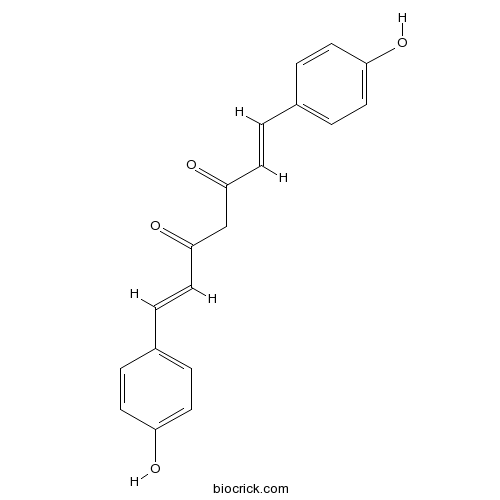A β-diketone that is methane in which two of the hydrogens are substituted by 4-hydroxycinnamoyl groups.
Bisdemethoxycurcumin can regulate anti-inflammatory and anti-proliferative responses through a ROS-independent mechanism, also suppresses MCF-7 cells proliferation by inducing ROS accumulation and modulating senescence-related pathways.[1]
Bisdemethoxycurcumin directly accelerates gastric ulcer healing with potency equal to curcumin, its antiulcer effect might be due to its properties of decreasing gastric acid secretion and enhancing the mucosal defensive mechanism through suppression of iNOS-mediated inflammation.[2]
Bisdemethoxycurcumin differentially inhibit cancer cell invasion through the down-regulation of MMPs and uPA.[3]
Bisdemethoxycurcumin induces apoptosis in activated HSCs, but not in hepatocytes, by impairing cellular energetics and causing a downregulation of cytoprotective proteins, likely through a mechanism that involves CBR2.[4]
Bisdemethoxycurcumin has effects on 12-Ο-tetradecanoylphorbol-13-acetate-induced tumor promotion.[5]
Bisdemethoxycurcumin has antioxidant activities, inhibits ovarian cancer via reducing oxidative stress mediated MMPs expressions.[6,7]
English website: Bisdemethoxycurcumin
Japanese website: Bisdemethoxycurcumin
Chinese website: Bisdemethoxycurcumin
[1] Sandur SK, Pandey MK, Sung B,et al. Carcinogenesis, 2007, 28(8):1765-73.
[2] Mahattanadul S, Nakamura T, Panichayupakaranant P, et al. Phytomed Int J Phytother Phytopharmacol, 2009, 16(4):342-51.
[3] Li Y B, Gao J L, Zhong Z F, et al. Pharmacol Rep Pr, 2013, 65(3):700-9.
[4]Yodkeeree S, Chaiwangyen W, Garbisa S, et al. J Nutl Biochem, 2009, 20(20):87-95.
[5] Lee P J, Woo S J, Jee J G, et al. Molecules, 2015, 20(1):1277-92.
Jayaprakasha G K, Rao L J, Sakariah K K. Food Chem 2006, 98(4):720-4.
[6]Huang M T, Ma W, Lu Y P, et al. Carcinogenesis, 1995, 16(10):2493-7.
[7] Pei H, Yang Y, Lin C, et al. Sci Rep, 2016, 6,28773.
[8] Jadhav B K, Mahadik K R, Paradkar A R. Chromatographia, 2007, 65(7):483-8.



